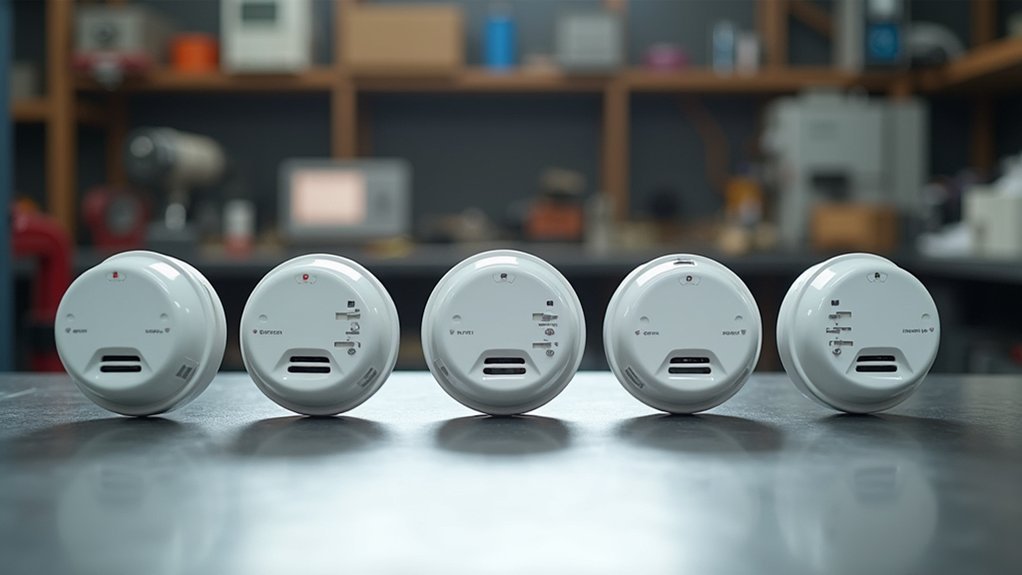You’re working with power tools, soldering irons, and flammable materials in your maker space, so fire safety can’t be an afterthought. Standard household smoke detectors often fail in these environments, triggering false alarms from dust and fumes or missing actual fires altogether. The wrong detector will either drive you crazy with constant beeping or leave you vulnerable when it matters most. These five models have proven themselves in real workshop conditions.
First Alert Smoke Alarm, Battery-Operated Detector (SMI100)
If you’re running a maker space where soldering, 3D printing, and woodworking create various airborne particles, the First Alert SMI100’s Precision Detection technology makes it an ideal choice since it minimizes false alarms from cooking and crafting activities while maintaining reliable fire detection. You’ll appreciate the front-access battery compartment for quick 9V battery changes during maintenance. The ionization sensor provides dual detection capabilities for smoke and fire, while the test/silence button lets you verify functionality monthly. At 5.4 inches square and weighing just 0.7 pounds, it installs easily anywhere. The unit alerts you when it’s time for replacement after ten years of service.
Best For: Maker spaces, workshops, and homes where cooking or crafting activities generate airborne particles but reliable fire detection is still essential.
Pros:
- Precision Detection technology minimizes false alarms from cooking and crafting activities
- Front-access battery compartment allows quick and easy 9V battery replacements
- Compact 5.4-inch design with lightweight 0.7-pound construction for easy installation anywhere
Cons:
- Requires frequent battery replacements approximately every three months according to user reports
- Ionization sensor may be more sensitive to small particles compared to photoelectric sensors
- 10-year replacement cycle means the entire unit needs to be replaced rather than just serviced
X-Sense Mini Smoke Alarm, 10-Year Battery (XS01, 6-Pack)
The X-Sense Mini Smoke Alarm XS01 6-pack delivers exceptional value for maker spaces that need extensive coverage without the hassle of frequent battery changes. You’ll get six compact detectors with 10-year batteries that won’t need replacement until the entire unit’s lifespan ends. Each unit covers 215-430 square feet using advanced photoelectric sensors that sample air three times every 10 seconds. You’ll appreciate the low-profile design and simple screw-in installation. However, you should be aware that some units arrive damaged or malfunction early, and customer service response can be slow when addressing reliability issues.
Best For: Maker spaces, workshops, and facilities that need extensive smoke detection coverage across multiple areas without the maintenance burden of regular battery replacements.
Pros:
- 10-year battery life eliminates the need for frequent battery changes across all six units
- Advanced photoelectric sensors sample air three times every 10 seconds for reliable smoke detection with low false alarm rates
- Compact, low-profile design with easy screw-in installation makes deployment simple across multiple locations
Cons:
- Some units may arrive damaged or malfunction early, creating reliability concerns
- Customer service response times can be slow when addressing product issues
- Entire unit must be replaced after 10 years since batteries cannot be individually replaced
X-Sense Smoke Alarm with 10-Year Battery (SD2J0AX)
Budget-conscious makers who need reliable fire protection without complex connectivity features will find the X-Sense SD2J0AX an ideal choice for their workshops. This standalone unit delivers essential smoke detection using advanced photoelectric sensors and intelligent ST chipset technology, ensuring quick response to smoldering fires common in maker environments.
You’ll appreciate the 10-year lithium battery that eliminates frequent replacements and provides continuous protection during power outages. The dust-proof isolating plate enhances sensitivity, while smart auto-check functionality monitors system health and alerts you to malfunctions or low battery conditions.
Installation couldn’t be simpler—you can mount it using screws or magnetic adhesive pads. The premium ABS plastic housing offers fire-retardant properties and resists high temperatures and corrosion.
Best For: Budget-conscious homeowners and makers who need reliable standalone smoke detection without wireless connectivity features for workshops, garages, or basic home protection.
Pros:
- 10-year lithium battery eliminates frequent replacements and provides continuous protection during power outages
- Advanced photoelectric sensor with dust-proof isolating plate delivers quick, accurate detection of smoldering fires
- Simple installation with multiple mounting options and durable fire-retardant ABS plastic housing
Cons:
- No wireless interconnection capability to link multiple units throughout a home
- Lacks Wi-Fi connectivity for smartphone alerts or remote monitoring
- Magnetic adhesive pads for installation are not included with the unit
Kidde Smoke Detector, 10-Year Battery Powered, LED Warning Light Indicators
Enhanced sensing technology makes the Kidde 20SD10 smoke detector an excellent choice for maker spaces where soldering, 3D printing, and other activities can trigger false alarms in standard detectors. You’ll appreciate the photoelectric sensor that reduces cooking-related false alarms while maintaining reliable smoke detection.
The 10-year lithium battery eliminates maintenance hassles—no midnight chirping or battery replacements. Installation’s simple with the twist-and-click bracket requiring no wiring. Three LED indicators keep you informed: green for normal operation, amber for errors, and red for smoke detection.
At 85 decibels with three long beeps, you’ll hear alerts clearly over workshop noise. The compact 5-inch design fits anywhere, and it’s tested to meet UL 217 standards for reliability.
Best For: Maker spaces, workshops, and homes where soldering, 3D printing, or cooking activities frequently trigger false alarms with standard smoke detectors.
Pros:
- Enhanced photoelectric sensing technology reduces false alarms from cooking and workshop activities while maintaining reliable smoke detection
- 10-year lithium battery eliminates maintenance with no battery changes or low-battery chirping for the entire lifespan
- Simple twist-and-click installation requires no wiring and includes clear LED indicators for operational status
Cons:
- Higher upfront cost compared to standard battery-powered smoke detectors
- Entire unit must be replaced after 10 years rather than just changing batteries
- Some customers reported installation challenges despite the simple design
X-Sense Smoke Detector with 10-Year Battery (1-Pack)
Advanced photoelectric sensing technology makes the X-Sense SD2L0AX smoke detector an ideal safety solution for maker spaces where slow-burning fires from wood dust, fabric, or electrical components pose significant risks. You’ll appreciate the hassle-free installation that doesn’t require rewiring—simply mount it with included screws or the optional magnetic pad. The sealed 10-year lithium battery eliminates decade-long maintenance concerns that plague busy workshops. With 4.5-star ratings from over 3,000 customers, this detector consistently delivers reliable performance. The auto-check function monitors battery levels and faults automatically, while the LED indicator and silence button provide convenient operation for your creative workspace.
Best For: Maker spaces, workshops, and homeowners seeking a low-maintenance smoke detector with 10-year battery life and reliable photoelectric sensing for slow-burning fires.
Pros:
- 10-year sealed lithium battery eliminates the need for battery replacements during the entire decade
- Advanced photoelectric sensor specifically designed to detect slow-burning fires from wood dust, fabric, and electrical components
- Tool-free installation with multiple mounting options including screws, anchor plugs, or magnetic adhesive pad
Cons:
- Not wireless or Wi-Fi compatible, limiting smart home integration capabilities
- Some users have noted concerns about alarm sensitivity testing and performance verification
- Standalone unit design means no interconnected alarm system for larger spaces or multi-room coverage
Factors to Consider When Choosing the Most Reliable Smoke Detectors for Maker Spaces
When you’re selecting smoke detectors for your maker space, you’ll need to evaluate several critical factors that directly impact safety and functionality. Consider the detection technology types available, as different sensors respond better to specific fire scenarios common in workshop environments. You’ll also want to assess false alarm prevention capabilities, battery longevity, installation complexity, and how well the units resist dust, humidity, and temperature fluctuations typical in maker spaces.
Detection Technology Types
Understanding detection technology types becomes essential since maker spaces present unique fire hazards that require tailored smoke detection approaches. You’ll encounter two primary sensing technologies: ionization sensors excel at detecting fast-flaming fires from electrical equipment, while photoelectric sensors better identify smoldering fires and reduce false alarms from soldering or cooking activities.
For maximum reliability, you should consider dual sensors that combine both ionization and photoelectric capabilities. These advanced systems respond effectively to various smoke types common in maker environments. Photoelectric sensors periodically sample air for smoke particles, helping differentiate between harmless vapor from projects and actual fire threats.
Your detector’s effectiveness depends on matching the technology to your space’s specific activities and environmental conditions, including temperature ranges and humidity levels.
False Alarm Prevention
Since maker spaces generate frequent smoke-like emissions from soldering, 3D printing, and laser cutting, you’ll need detectors specifically engineered to distinguish between project byproducts and actual fire threats. Advanced sensing technologies like Precision Detection and photoelectric sensors minimize cooking nuisance alarms while providing early fire warnings. Look for models with dust-proof isolating plates that maintain sensitivity to true smoke while preventing false alarms from debris accumulation.
Choose detectors with 10-year lithium batteries to eliminate low battery chirps that trigger unnecessary alerts. Regular testing and maintenance greatly enhance reliability since malfunctioning alarms produce more false alarms. These features guarantee your smoke detector accurately detects slow-burning fires without interrupting productive work sessions in your maker space.
Battery Life Considerations
Battery life directly impacts your smoke detector’s reliability, making it a critical factor in maintaining consistent protection throughout your maker space. You’ll want to prioritize units with lithium batteries that offer 10-year lifecycles, eliminating frequent replacements and ensuring continuous protection while you’re focused on projects. Avoid detectors using standard alkaline batteries, which require replacement every three months and increase maintenance burden.
Look for models with end-of-life notifications that alert you when replacement’s necessary, ensuring compliance with fire safety regulations. Choose detectors featuring self-check capabilities that monitor battery status and overall functionality automatically. This reduces your workload while maintaining ideal safety standards. Longer-lasting batteries provide peace of mind, allowing you to concentrate on creating without constantly worrying about detector maintenance or unexpected failures.
Installation Requirements
Proper installation determines whether your smoke detectors will function effectively when emergencies strike in your maker space. You’ll want detectors offering multiple mounting options—screw-in installation for permanent placement or adhesive mounting for quick setup on various surfaces. Choose models with front-access battery compartments that allow swift battery changes without removing the entire unit, or invest in 10-year lithium battery units that eliminate maintenance headaches.
Ensure your selected detectors include complete installation hardware like screws and anchor plugs, plus clear setup instructions. Consider the detector’s size and profile to avoid obstructing workbenches, equipment, or workflow areas. Most importantly, verify compliance with local safety standards and building codes specific to commercial workshop environments before finalizing your purchase.
Environmental Resistance Features
Beyond proper mounting and placement, your smoke detectors must withstand the challenging conditions found in most maker spaces. You’ll need devices that operate effectively within a 40-100°F temperature range while tolerating humidity levels up to 95%. This environmental resistance guarantees consistent performance whether you’re welding, 3D printing, or working with power tools that generate heat.
Look for detectors with dust-proof isolating plates that enhance sensitivity while reducing false alarms from airborne particles created during cutting, sanding, or drilling. Fire-retardant materials are essential since your detector must survive high temperatures without sustaining damage during actual fire incidents.
Choose models with regular self-testing features and auto-check functionality. These advanced capabilities maintain reliability despite the demanding environmental conditions, guaranteeing your detector remains operational when you need it most.
Coverage Area Capacity
Most smoke detectors cover between 215 to 430 square feet, so you’ll need to calculate your maker space’s total area before selecting units. If your workshop exceeds a single detector’s capacity, install multiple units strategically throughout the space to guarantee complete coverage. Don’t assume one detector will handle a large area effectively.
Consider your space’s layout when determining placement. Open floor plans may require fewer detectors than compartmentalized areas with walls or partitions that could block smoke flow. Calculate the square footage of each distinct area separately.
For peak performance, position detectors near ceilings where smoke naturally rises. This placement maximizes detection efficiency and guarantees early warning. You’ll also need to account for high-ceiling spaces, which may require specialized mounting or additional units for proper coverage.
Frequently Asked Questions
How Often Should Smoke Detectors Be Tested in Maker Spaces?
You should test smoke detectors in maker spaces monthly at minimum. Given the higher fire risks from soldering, cutting, and dust, consider weekly testing. Don’t forget to check batteries quarterly and replace units every ten years.
Can Welding or Soldering Trigger False Alarms in Smoke Detectors?
Yes, you’ll experience false alarms from welding and soldering. Both activities produce smoke, fumes, and particles that’ll trigger photoelectric detectors. You should install heat detectors or beam-type detectors in welding areas instead.
What’s the Ideal Mounting Height for Smoke Detectors in Maker Spaces?
You’ll want to mount smoke detectors 4-12 inches from the ceiling on walls, or centered on ceilings. In maker spaces with high ceilings, don’t exceed 30 feet height for proper smoke detection coverage.
Do Smoke Detectors Need Special Certification for Commercial Maker Spaces?
You’ll need UL-listed detectors meeting commercial building codes for maker spaces. Check local fire marshal requirements, as they often mandate addressable fire alarm systems with professional monitoring rather than basic residential units.
How Do You Prevent Dust From Woodworking From Affecting Detector Performance?
You’ll want to install dust covers or shields around detectors, maintain proper ventilation systems, and regularly clean detector sensors. Consider using photoelectric models instead of ionization types since they’re less sensitive to fine dust particles.





Leave a Reply